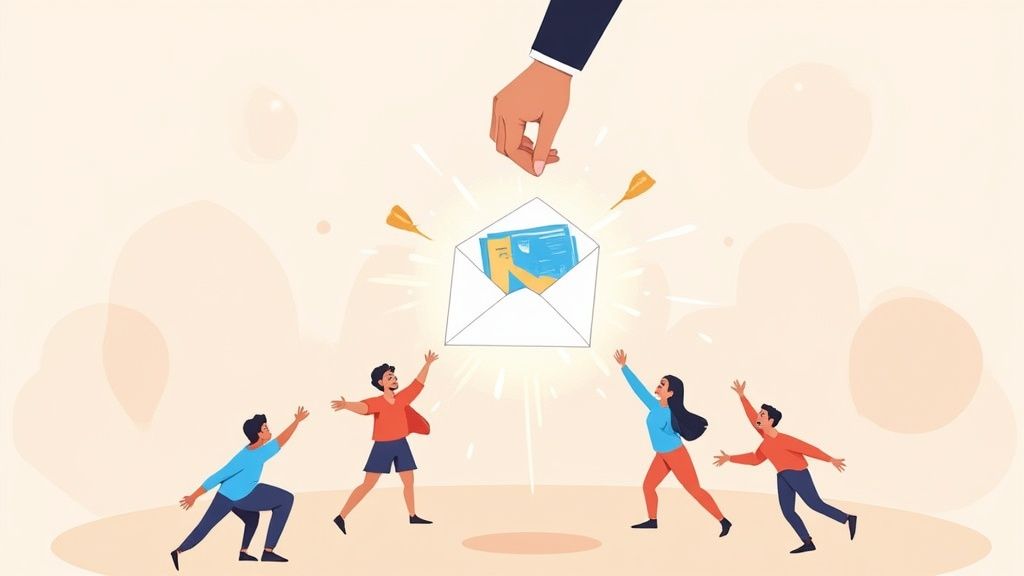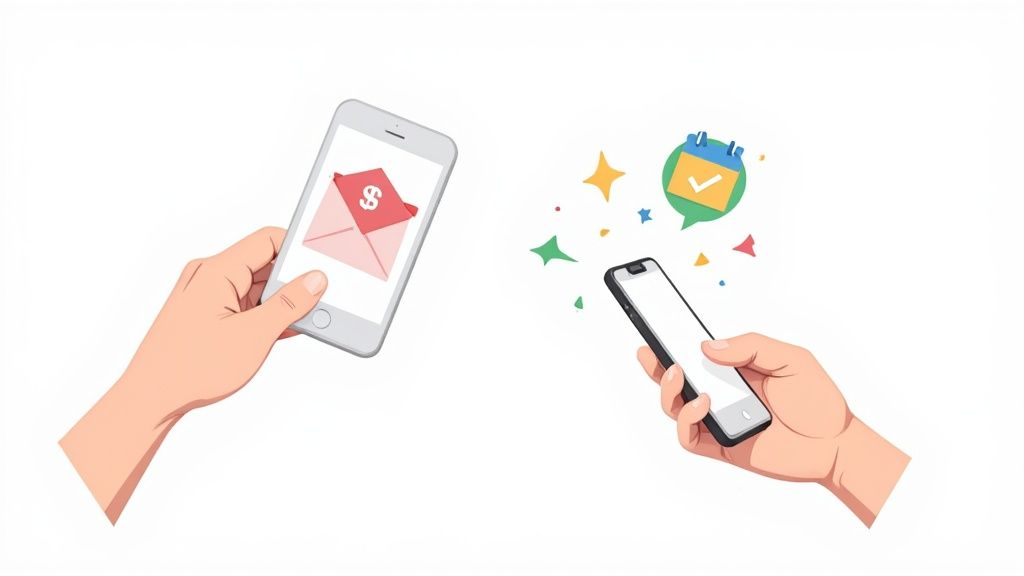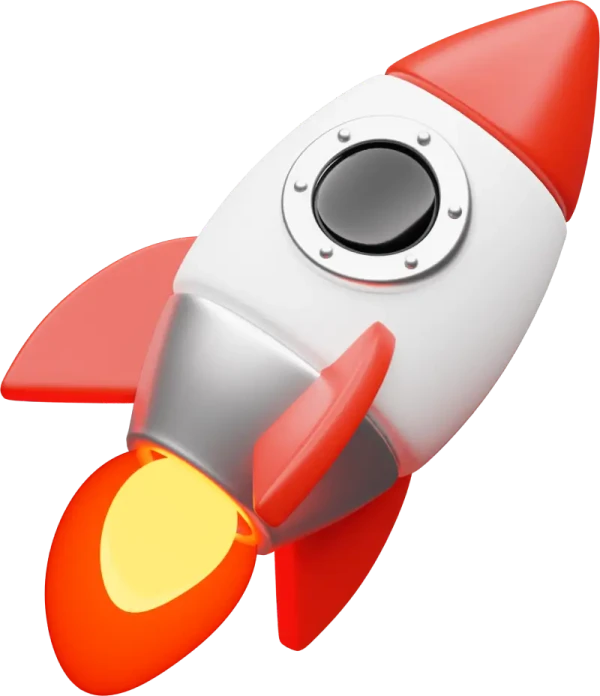Anyone can send an invite. That part's easy. The real trick is getting people to actually say "yes" and show up. It all starts with crafting a message that cuts through the noise in a crowded inbox and clearly shows why your event is worth their time.
You've got to strike that perfect balance between giving them all the essential details and building genuine excitement from the moment they see your email.
Crafting an Invite That Actually Gets Opened
Let's be honest, getting your invite into someone's inbox is one thing; getting them to open it, read it, and - most importantly - attend your event is a whole different ball game. The first step isn't just hitting "send." It's about writing a message that makes your event feel completely unmissable.
This all begins with a magnetic event title. Instead of something generic like "Q3 Marketing Webinar," why not try "Unlock Your Q3 Growth: Top 5 Marketing Hacks"? See the difference? The second one immediately tells your guest what’s in it for them.
From there, a clear, concise description is your best friend. Your guests are busy, so get straight to the point. Clearly outline the who, what, when, where, and why. Think of it as the first positive experience your guest will have with your event - make it a good one.
Essential Elements of a High-Conversion Invite
To make your invitation as effective as possible, there are a few must-have components that work together to drive RSVPs and build anticipation.
Here's a quick rundown of what every great invitation needs to get the job done.
| Component | Why It's Critical | Pro Tip |
|---|---|---|
| Compelling Subject Line | It's your first impression and the gatekeeper to your message. | Be specific and intriguing. Lead with the biggest benefit for the attendee. |
| Clear Value Proposition | Answers the "Why should I attend?" question immediately. | Highlight a key takeaway, a special guest, or a unique experience they'll get. |
| Essential Event Details | Prevents confusion and makes it easy for guests to plan. | Bold the date, time (with time zone!), and location (virtual link or physical address). |
| A Sense of Urgency | Motivates people to act now instead of putting it off. | Phrases like "Limited spots available" or "Early bird ends Friday" work wonders. |
By including these elements, you're not just sending an invite; you're providing a clear, compelling reason for someone to give you their time.
Timing is just as crucial as the content itself. We've seen that sending formal invitations about eight weeks before an event can help achieve an optimal acceptance rate of around 80%. It gives people enough time to plan without letting it fall off their radar.
Thinking through the entire journey - from the moment they see your email to the day of the event - is key. If you're looking for more inspiration, we put together a guide with a sample event invitation email that pulls all these ideas together.
Focus on these elements, and you'll sidestep the common mistakes that lead to confusing invites and low response rates. You'll be setting the stage for a well-attended, successful event.
Getting Your Event Directly Into Their Calendar
A killer subject line and a clear description are great, but the real win is getting your event off the email and onto their actual schedule. This is where you have to remove every bit of friction. Instead of just hoping they'll bother to create a calendar entry manually, you can give them a simple, powerful tool: an "Add to Calendar" button.
That one click turns a passive email they might forget about into a solid block of time in their calendar. With a service like ours, we make this a no-brainer. The goal is to eliminate the manual data entry that so often stops people from following through. Think of a tech company running a weekly webinar series - they can create one event template in our dashboard and reuse it endlessly, saving hours of tedious work.
Turning an Invite Into an Action
It all starts with creating the event itself inside our dashboard. You'll enter all the essential details just once - the title, date, time, location (whether it's virtual or physical), and a good description. This keeps all your event info in one place, making it a breeze to manage.
Here’s what the event creation screen looks like in our dashboard.
As you can see, every field is straightforward. It’s all designed to capture the information that will populate your attendees' calendars perfectly. Once you hit save, our system generates a unique link for that event.
This link is where the magic happens. You can embed it as a button in your email newsletter, share it directly on social media, or even drop it onto a landing page. Imagine a local yoga studio promoting a new workshop; they can post the link on Instagram, and followers can add it to their calendar right from their phones. Super simple.
If you're sending more traditional invites, you can find extra tips in our guide on how to send a Google Calendar invite to round out your process.
Customizing the Experience
A generic button is fine, but a branded one? That’s next level. You can customize the look and feel of your Add to Calendar button to match your brand's aesthetic perfectly - we're talking colors, fonts, and styles. This creates a seamless and professional experience for your audience, from the email all the way to their calendar.
The key takeaway here is control and convenience. You're not just throwing information at people; you're giving them a tool that makes their lives easier. When you remove those barriers, you dramatically increase the chances of them actually committing to and remembering your event.
This approach makes sure your event doesn't just get buried in a crowded inbox. It secures that valuable real estate on their personal calendar, turning your invite into a priority they won’t forget.
Choosing Where to Send Your Invite for Max Reach
You've crafted the perfect invite, but it’s completely useless if it never reaches the right people. Where you send your invitation matters just as much as what's in it. After all, you can have the most compelling message in the world, but it won’t land if it's delivered to an empty room.
This is all about matching your distribution channel to your specific event and audience for the biggest impact.
The game plan for promoting a B2B webinar is worlds apart from how you’d announce a community festival. The webinar will do best with a hyper-targeted email campaign to a segmented list of professionals. Meanwhile, the festival is going to thrive on the broad, visual appeal of an Instagram Story. Your job is to pick the right tool for the job.
This infographic breaks down some of the most popular channels people are using to send invites today.
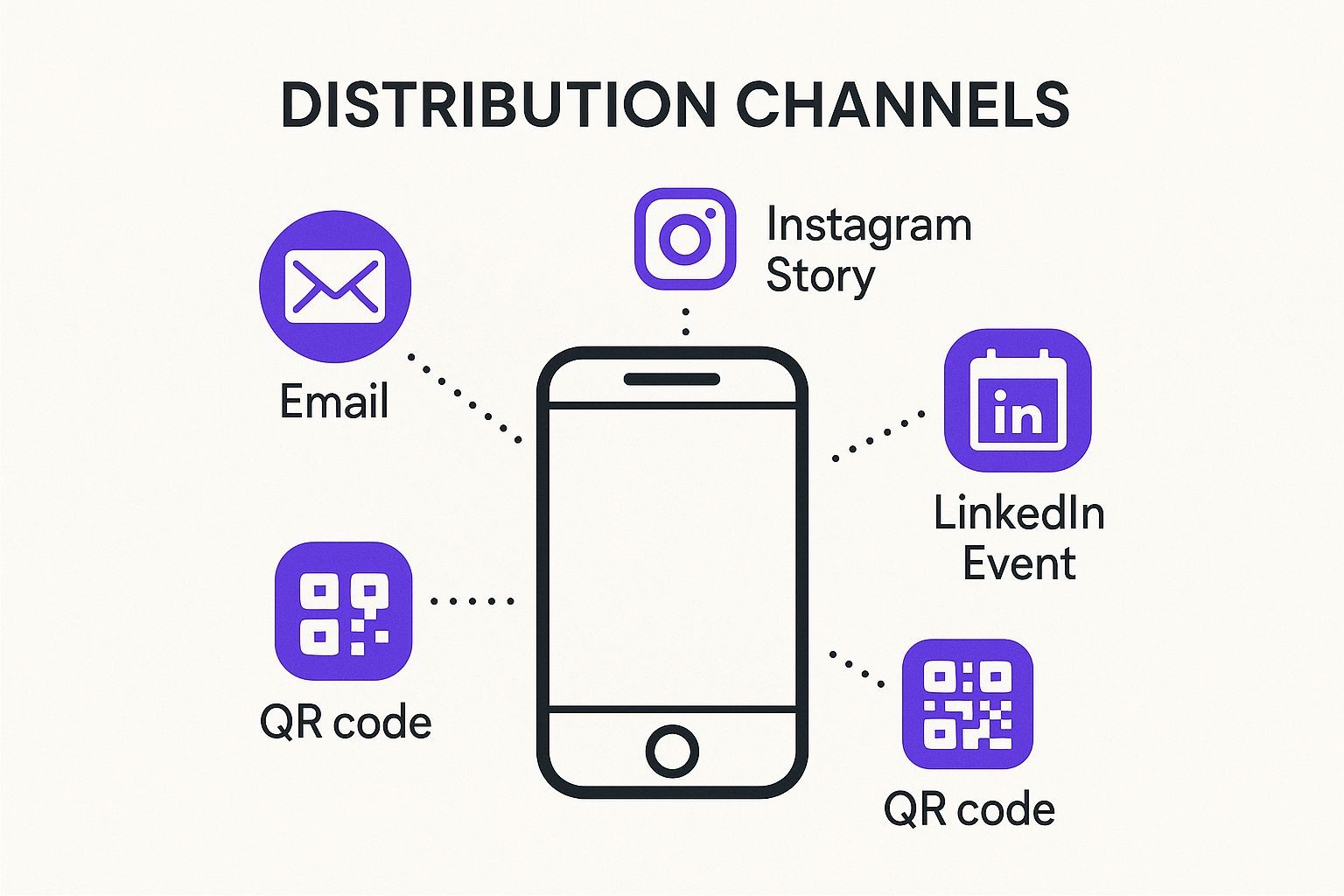
Each channel serves a unique purpose. You've got the directness of email, the high-engagement potential of social platforms like Instagram, and the professional focus of LinkedIn.
Aligning Your Channel With Your Audience
Seriously, think about where your target audience naturally hangs out online. A professional networking event will get way more traction using LinkedIn Events than it ever would on TikTok. LinkedIn’s whole platform is built for professional connections, making it the perfect spot to share event details and kick off industry-specific discussions. The engagement you get there is actually relevant.
On the other hand, a local coffee shop hosting a latte art workshop could see huge success with a simple QR code on an in-store flyer. This approach grabs the attention of existing customers who are already physically there and interested in the brand. The barrier to entry is almost zero - they just scan and go.
The most effective distribution strategy isn't about blasting your invite across every channel available. It's about choosing the few that directly connect you with your ideal attendees. Quality of reach will always, always trump quantity.
Choosing the Right Channel for Your Event
Deciding where to send your invite can feel overwhelming with so many options. To make it easier, here is a quick comparison of the most popular channels to help you see where your event might fit best.
Invitation Channel Effectiveness Comparison
This table breaks down popular channels for sending digital invites, helping you choose the best fit for your event.
| Channel | Best For | Engagement Potential | Considerations |
|---|---|---|---|
| Email Marketing | Formal announcements, B2B webinars, targeted campaigns, sending updates. | Medium to High. Highly personal and direct. | Requires a quality email list. Can get lost in cluttered inboxes if not compelling. |
| Professional conferences, networking events, industry-specific workshops. | High. Reaches a professional audience; easy sharing among connections. | Less effective for casual or B2C events. Your company page or personal profile needs a presence. | |
| Instagram/Facebook | Community events, product launches, workshops, festivals, creative gatherings. | Very High. Visual-first, great for stories, paid ads can target specific demographics. | Can be "pay to play." Organic reach can be limited without a strong following. |
| QR Codes (In-Person) | Local events, retail promotions, trade shows, in-store workshops. | High (at the moment of scan). Captures an already engaged, physically present audience. | Reach is limited to foot traffic. The code needs to be placed in a high-visibility area. |
This isn't an exhaustive list, but it covers the heavy hitters. The key is to look at your event's goals and your audience's behavior, then pick the channel that aligns best. You might even find a combination of two works wonders.
Ultimately, you need a clear framework. Before you send anything, just ask yourself two simple questions to guide your decision:
- Who is my audience? Get specific about their demographics, job roles, and online habits.
- What is the nature of my event? Is it a formal conference, a casual get-together, an educational webinar, or purely social?
Answering these questions honestly will help you filter out the noise and focus your energy where it will actually count. This ensures your carefully crafted message not only gets delivered but also lands with genuine impact, setting the stage for a packed house.
Using Automation to Reduce Event No-Shows
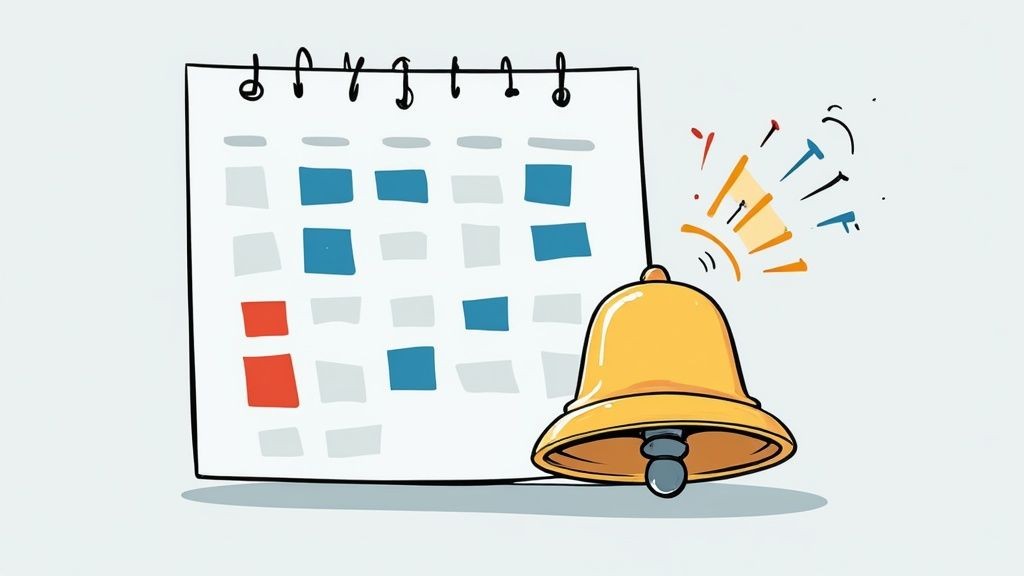
Getting someone to RSVP is a great first step, but that's only half the battle. The real challenge is making sure those people actually turn up. An RSVP is just an intention, not a firm commitment. This is where smart automation becomes your secret weapon, turning hopeful RSVPs into actual, engaged attendees.
You can't just send an invite and cross your fingers. You need a solid game plan for what happens after they click "yes." This post-RSVP period is where you either keep your event top-of-mind or get lost in the noise. It’s all about building a bridge from their initial interest to their final attendance.
Set Up Automated Event Reminders
One of the most powerful ways to fight the no-show problem is with automated reminders that go straight to your attendees' calendars. With our service, you can schedule these reminders to go out at key moments - think a week before, the day before, and even an hour before showtime.
These aren't just another email buried in a crowded inbox. They are native calendar notifications that pop up right on their phone or computer. It's a perfectly timed, impossible-to-ignore nudge.
Track Calendar Adds to See Who's Serious
Forget relying on fuzzy metrics like email open rates. A far more telling sign of commitment is when someone adds your event to their calendar. That single action shows a much stronger intent to show up.
Within our platform, you can track this specific metric, giving you a much clearer picture of who's likely to attend.
Tracking calendar adds gives you real insight into attendance intent. If you see a ton of RSVPs but a low number of calendar adds, that's your cue to adjust your follow-up strategy and send out a targeted reminder.
This data lets you move from guessing to knowing. For example, if you're in the wedding industry, knowing that search interest for "wedding invitations" spikes in January can help you time your promotional pushes for maximum impact. You can dig into more of these seasonal invitation trends on Accio.com to sharpen your timing.
Customize Your Confirmation Messages
The second someone RSVPs is a golden opportunity to reinforce your brand and provide immediate value. You can customize the confirmation messages attendees see the moment they add the event to their calendar.
Use this space to do more than just say "thanks":
- Remind them why they signed up by restating the event's core value.
- Give them a direct link to the webinar platform or event space.
- Share a link to pre-event reading materials or an online community forum.
This creates a polished, professional experience right from the get-go. For a deeper dive into these pro-level moves, check out our guide on event marketing automation. It's these kinds of thoughtful touches that truly convert an RSVP into an attendee.
Let's be honest, paper invites are a thing of the past. Moving to digital isn't just about being green - it's a critical move for anyone who's serious about running events smoothly. From massive corporate conferences to one-person consulting gigs, event planners are all-in on digital for one simple reason: it just works better.
The benefits are impossible to ignore. You get immediate savings on printing and postage, sure, but the real power comes from real-time tracking and the ability to send instant updates. These aren't just small perks; they're fundamental upgrades to how events are managed.
Keeping Up with the Pace of Modern Events
Picture this: you have to change a webinar link or update a meeting location at the very last minute. The old way? You’d be scrambling to send a frantic "CORRECTION" email, crossing your fingers that everyone sees it in time.
With a digital system, you update the event in one spot, and that change automatically syncs to every single person's calendar.
That’s a total game-changer. This is exactly why tools like ours exist - to meet the fast-paced, ever-changing demands of modern events.
And the market agrees. The global e-invitation software market was valued at around $5.8 billion in 2023 and is expected to rocket to $15.3 billion by 2033. This boom is driven by our universal shift to digital communication and cloud-based tools, especially in the corporate world. You can dig deeper into the growth of the e-invitation market on DataHorizzon Research.
When you go digital-first, you're not just sending static information anymore. You're creating a live, dynamic link between your event and your audience's schedule, making sure everyone stays perfectly in sync, no matter what happens.
At the end of the day, digital invites give you a level of control, professionalism, and responsiveness that paper methods can't even touch. It’s all about working smarter, not harder.
Got Questions About Sending Invites?
Even with the best tools, a few questions always pop up. It's understandable. As someone who lives and breathes event marketing, I've heard them all. Let's walk through a few of the most common ones so you can send your next invite with total confidence.
Figuring out the timing is a classic one, especially for virtual events. It's a bit of an art form, really - a balancing act between giving people enough notice and not being so early they forget all about you.
What Is the Best Time to Send an Invite for a Webinar?
For something like a webinar, that first invitation should go out 2-3 weeks in advance. That seems to be the sweet spot. It gives people enough runway to clear their schedule but isn't so far out that it just becomes a distant memory.
But don't just send it and forget it. A few friendly nudges are crucial. We always recommend a reminder cadence that looks something like this:
- One week before the event
- Another ping the day before
- A final "see you soon!" message one hour before you go live
The beautiful thing is, when your attendees use an 'Add to Calendar' link, their own calendar app usually takes care of these reminders automatically. It's a massive help for cutting down on no-shows and takes a lot of the follow-up weight off your shoulders.
Can I See How Many People Added My Event to Their Calendar?
You absolutely can. And honestly, you should. While your email platform is great for tracking opens and clicks, those numbers don't tell the whole story. An open isn't a commitment. With our analytics, you can see a metric that actually matters: calendar adds.
Knowing how many people took the step to put your event on their Google, Outlook, or Apple calendar gives you a much realer sense of their intent to show up. This is the data that shows you how effective your campaign really is, way beyond simple email engagement.
This single metric provides a much clearer forecast for attendance than any other. It helps you understand who is genuinely planning to be there, allowing you to focus your follow-up efforts more effectively.
How Do I Handle Event Changes After Sending the Invite?
Ah, the dreaded last-minute change. This is where a dynamic calendar service really shines. If a time, link, or even the location of your event has to change, you just pop into your Add to Calendar PRO dashboard and update the details there.
Once you hit save, the event in your attendees' personal calendars will automatically sync with the new info. No more frantic "CORRECTION" emails. No more confusion. Everyone just has the right details, instantly. It’s a lifesaver.
Ready to make your event unforgettable and ridiculously easy to attend? Add to Calendar PRO gives you the tools to create, share, and manage your events like a pro. Get started and see how simple it is to boost your attendance rates.
